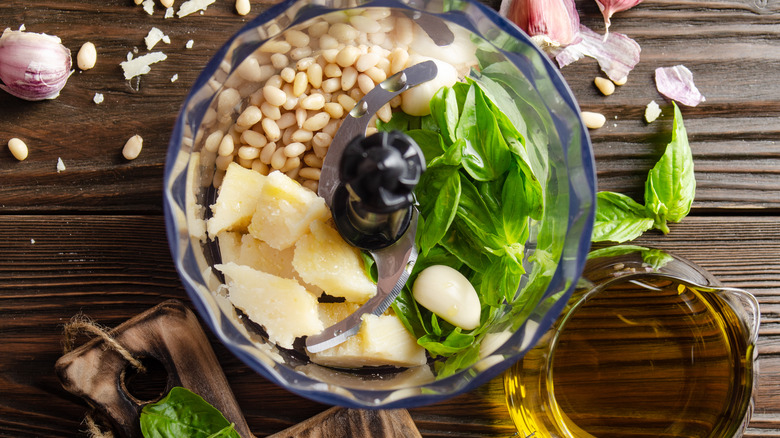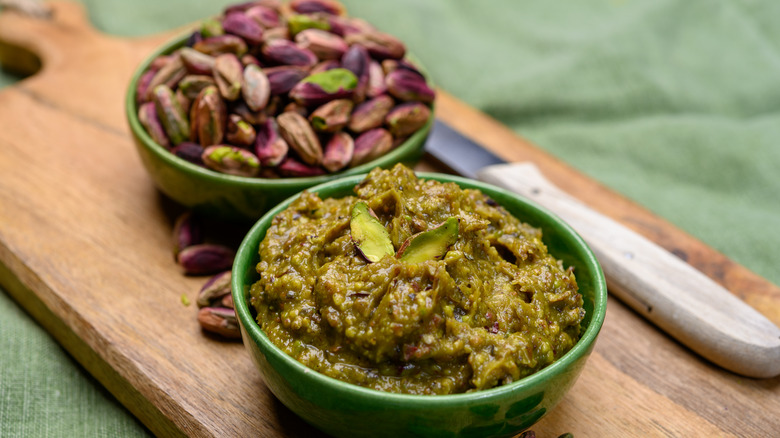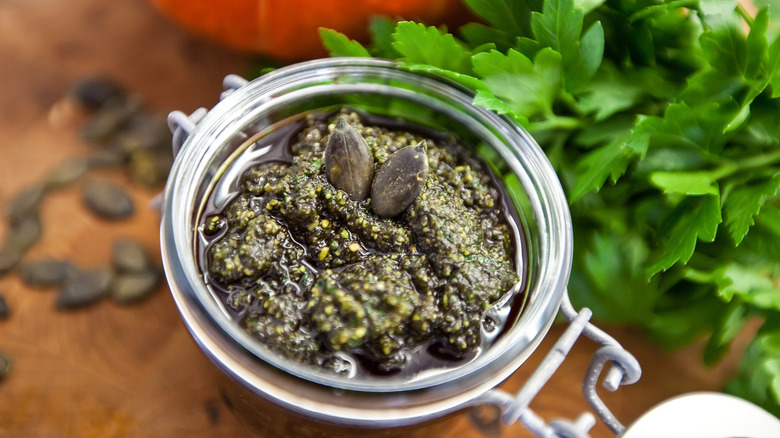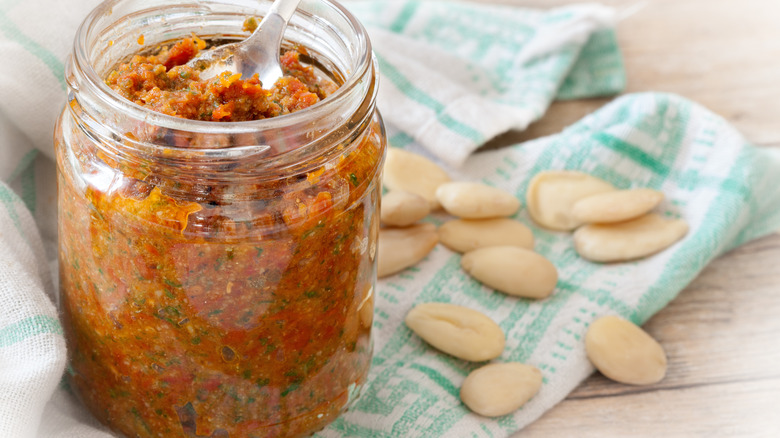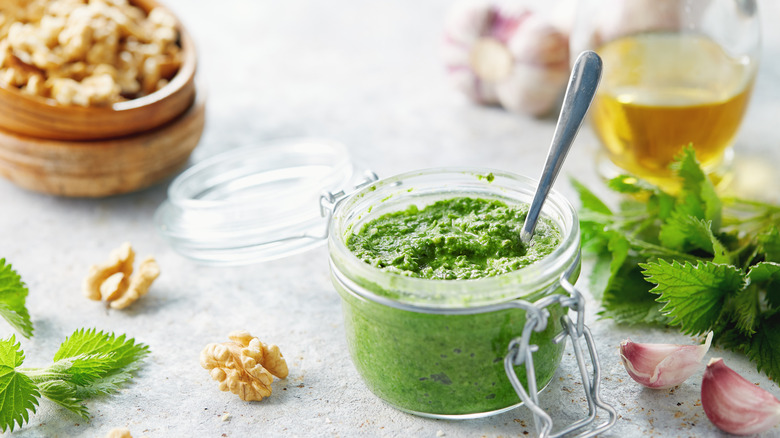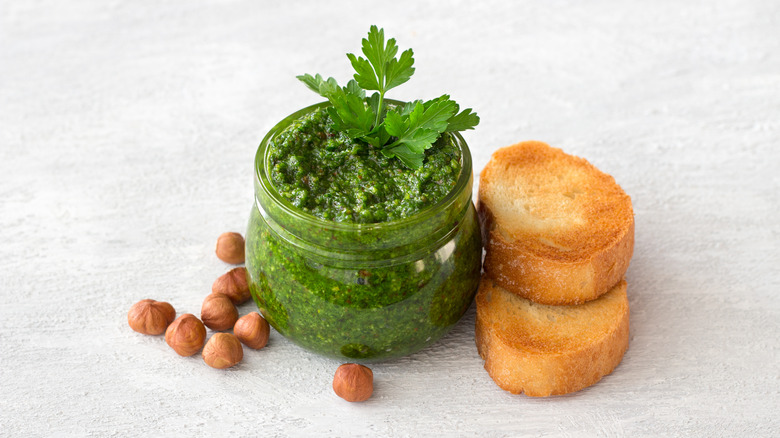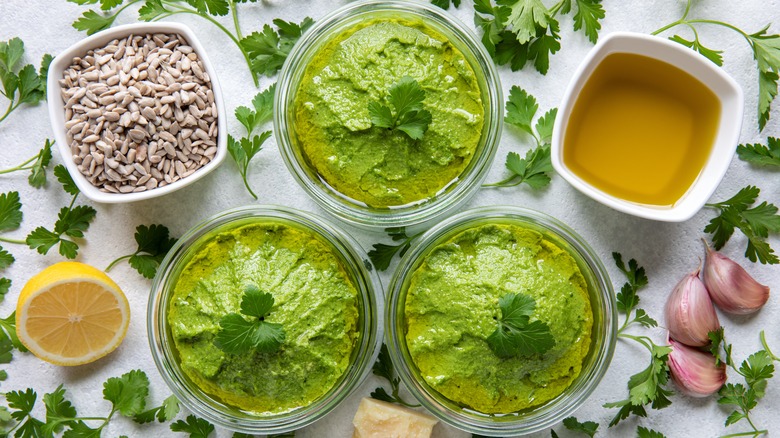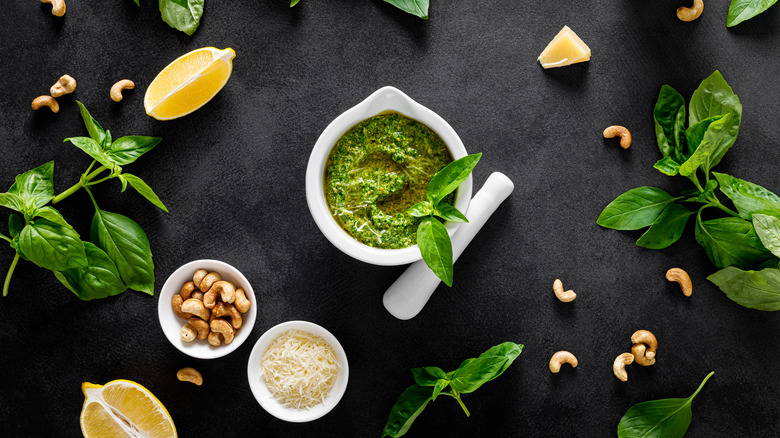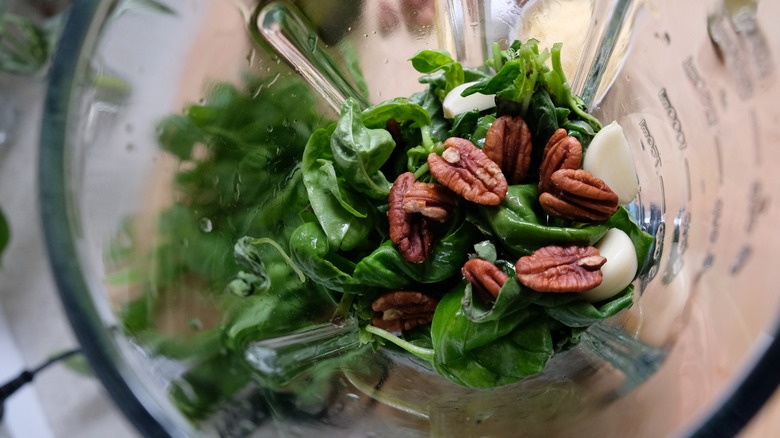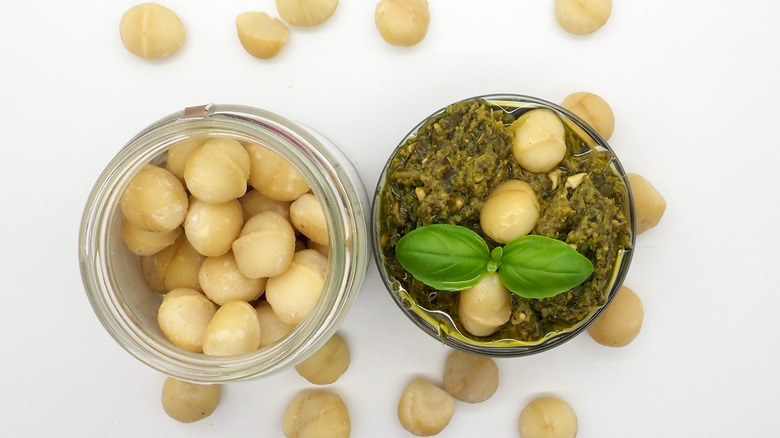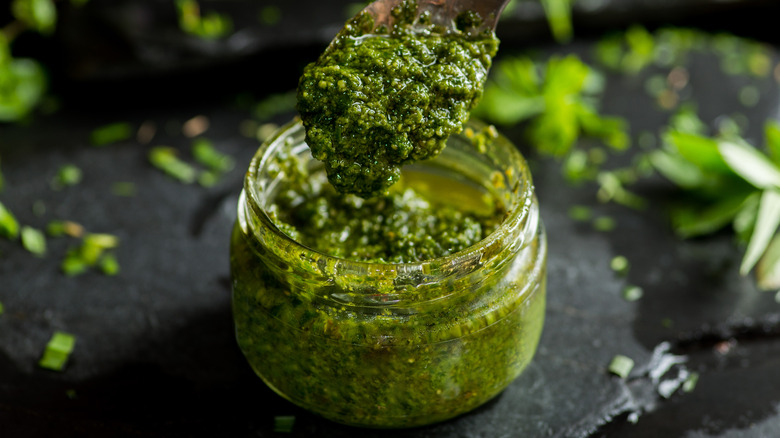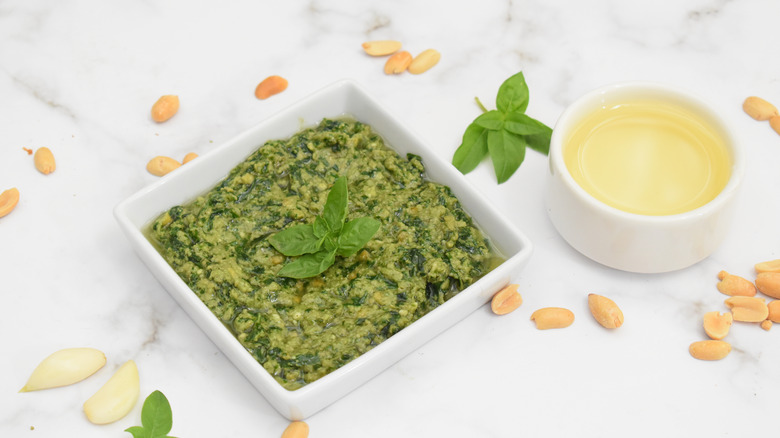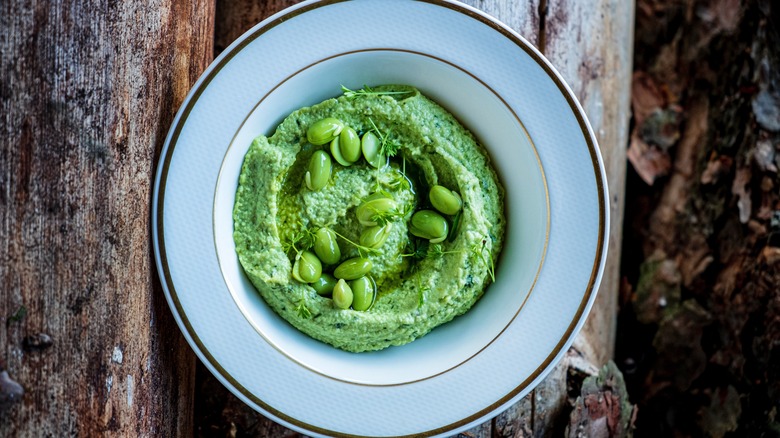11 Best Pine Nut Substitutes For Pesto
Pesto is a staple dish of Italian cooking and an excellent, light way to enjoy pasta. The term doesn't refer to specific ingredients but the preparation method. Making pesto means turning all the ingredients to paste using a blender. The most common pesto ingredients are basil, pine nuts, parmesan, olive oil, garlic, and lemon juice. You can swap any of these ingredients, depending on what you want in your pesto recipe. For example, change the cheese with capers if you want a lighter version, like in this bright and fresh pesto recipe.
Although pine nuts are essential in classic pesto recipes, you can substitute them with many other ingredients. Substitution could appeal to you for many reasons, but sustainability and price are the most important. Pine nuts are not environmentally friendly in terms of harvesting, as they can affect the development of their ecosystem. Because of the long time trees need to develop and the laborious harvesting process, pine nuts are also costly. The good news is that you can use many other ingredients in pesto to give it the same nutty and buttery flavor. Here are the best 11 pine nuts substitutes for your pesto recipe.
Pistachios
Pistachio is a nut from the same family of plants as the cashew. In fact, it is the seed of the fruit of the pistachio tree. Pistachios are available shelled or unshelled, and you can add them to savory and sweet recipes. Their taste is fresh, tangy, a bit salty, and with a hint of pine. They resemble pine nuts because of their flavor and can easily substitute in pesto recipes. The most significant advantage to using pistachios as a pine nut substitute is the price, as pistachios are much cheaper than pine nuts. They will also give your pesto a creamier texture.
If you replace pine nuts with pistachios in your basil pesto, you will need the same amount. For a more robust taste with a roasted nut flavor, roast the pistachios before adding them to the pesto, and, of course, don't forget to let them cool. You can substitute other recipe elements to play around with the ingredients. For example, go for a parsley–pistachio pesto recipe. With Grana Padano, lemon juice, and extra–virgin olive oil, this pesto recipe brings all the freshness and summery taste of parsley together with the tangy taste of lemon juice. These pair perfectly with the roasted pistachios. You can use pistachio pesto as a pasta or gnocchi sauce, a dip for fresh veggies or bread, mix it into mashed potatoes, or as a salad dressing.
Pumpkin seeds
With their salty, nutty, and concentrated flavor, pumpkin seeds are an often overlooked type of food. They mostly appear as a byproduct of pumpkins, so many people tend to discard them without thinking they are good to eat. However, there are many ways to consume pumpkin seeds, either roasted or raw. From salad toppings to candy brittle and pesto, pumpkin seeds can always add a bit of a crunchy kick to your savory or sweet foods.
You can substitute pumpkin seeds in your usual basil pesto recipe, or you can get creative and let yourself be inspired by chefs. Use the same pumpkin seed quantity as the required pine nuts in your recipe. For a Mexican twist, replace parsley with cilantro, and add queso fresco and lime juice to your pumpkin seed pesto. Or choose a chef specialty and make your pesto using chef Ashley Eddie's pumpkin seed pesto recipe. To make this, the chef uses warm toasted pumpkin seeds (that's different from the usual recipes, which require the toasted seeds to be cooled down), soffritto (an aromatic flavor base made with sautéed onions, celery, and carrots), pumpkin seed oil, and an anchovy fillet. The pumpkin seed pesto pasta works best served with rigatoni pasta combined with garlic, more anchovy fillets, olive oil, and lemon juice.
Almonds
Almonds are another type of seed often mistaken for nuts. They have a high nutritional value, are low in saturated fatty acids, are rich in unsaturated fatty acids, and are filled with fiber and protein. Almonds can be used in various recipes and are suitable for savory and sweet dishes. Roast almonds with honey and sesame, blend them into vegan butter, grind them into flour and use it for cake or delicious macarons, or substitute pine nuts in pesto. You can also use them for dips (combined with canned tomatoes), to make a crust for quiche, add them to your salads, and, of course, to make vegan almond milk. Almonds make an excellent pine nut substitute with their delicate, sweet–bitter taste and crunchy texture.
Replace the pine nuts in your pesto recipe with the same amount of almonds. If you want to freshen things up and go for a different taste, try a mint–almond pesto made with lemon juice. Toasting the almonds in this recipe will give you a more intense flavor that perfectly complements the mint. If you want a more complex pesto taste, use this almond mint–spinach pesto recipe, which includes more traditional pesto ingredients, such as Parmesan cheese. The extra spinach will guarantee that your pesto has a brighter green color. This pesto is best served with pasta but works excellently as a dip.
Walnuts
With their earthy and rich flavor, walnuts can successfully substitute pine nuts in pesto recipes. Walnuts are edible seeds produced by a type of tree and have many health benefits, as they are rich in omega-3 fats and antioxidants. Walnuts can be consumed either raw or as part of recipes, and they are an appreciated dessert ingredient. Add them to apple salad, pasta sauce, porridge, pumpkin bread, banana muffins, or carrot slaw. Walnuts can also be the source of plant-based milk (it will retain the specific flavor) or can be transformed into a cheese sauce (with the help of nutritional yeast).
You will need the same quantity of walnuts to substitute the pine nuts in your pesto recipe. Walnuts work well with basil and parsley in terms of flavors, so you can make basil–parsley and roasted garlic pesto. Another excellent combination for pesto is sage with walnuts, in which the two bitter and nutty flavors complement each other perfectly. Toast the walnuts for the recipe, as this will enhance their taste, and combine them with equal amounts of sage and parsley leaves, garlic, fresh lemon juice, lemon zest, freshly grated Parmesan cheese, and seasonings. You can freeze the walnut–sage pesto and preserve its wonderful fall flavor. Use it with pasta, add it as a pizza base, dip fresh apples and pears into it for a unique appetizer, and use it as a topping for grilled chicken or seafood.
Hazelnuts
A great source of dietary fiber with an exquisite taste, hazelnuts also contain manganese, vitamin E, fats, and protein. In diets, hazelnuts can lower cholesterol levels and improve insulin resistance. They are also a delicious addition to food and an appreciated source of plant-based milk and butter. You can use hazelnuts for all kinds of desserts, such as cookies, cupcakes, and granola, or add them to salads, stuffing, roasted veggies (they go well with Brussels sprouts), risotto, and orzo.
You can use hazelnuts to substitute pine nuts in pesto at a 1:1 substitution rate. The hazelnuts' sweet, musty, and earthy flavor goes well with basil in a classic pesto recipe with garlic, parmesan, lemon, and other herbs. However, a unique hazelnut pesto is the ramp pesto, which carries an explosion of flavors. Ramps, also called wild leeks, are wild, leafy vegetables that are usually forged. They taste like a combination of green garlic and scallions and are one of the first plants of spring. For the hazelnut–ramp pesto, toast the hazelnuts, remove their skins, and combine the main ingredients with Pecorino Romano cheese, olive oil, and seasonings. Serve the pesto with pasta or as a dip, and allow it to remind you of the fresh taste of spring.
Sunflower seeds
Sunflower seeds are probably the closest pine nuts substitution in pesto, as they have a similar taste and texture. Packed with fiber, protein, healthy fats, and minerals, sunflower seeds may promote heart health, have lots of antioxidants, and come reasonably priced. However, be mindful that although the seeds carry minimal salt, the pre-packed roasted version you can find in grocery stores has more salt. So instead, look for raw sunflower seeds, which you can toast yourself, or buy roasted seeds with no added salt.
As with other nuts or seeds, the substitution rate when replacing pine nuts with sunflower seeds in pesto is 1:1. You can use sunflower seeds in traditional basil pesto recipes or change more ingredients to have a gourmet dish. Pesto rosso is such an example. It's one of the few types of pesto that dares modify a vital aspect of the sauce, its color. Pesto rosso translates as "red pesto." Its main ingredient is not basil, but something almost equally flavorful, sun-dried tomatoes. With their sweet and umami aroma, sun-dried tomatoes pair perfectly with classical pesto ingredients, such as pecorino, parmesan, and garlic. Sunflower seeds are perfect to finish the taste, as they enhance their earthiness when lightly roasted and round up the umami flavor. Pesto rosso works best as a pasta or gnocchi sauce, but it is also delicious as crostini spread.
Cashews
Cashews are the seeds of a tropical evergreen plant that produces cashew apples. The seeds grow outside the fruit and contain a skin irritant. This substance is eliminated through processing, so the cashews you buy at the grocery store are safe to eat. Cashews have a distinctively creamy texture and a mild flavor, which makes them the perfect nuts to produce vegan cheese. Roasted cashew is ideal for adding to stir-fries, fried rice, or cashew chicken, as it brings a specific nutty flavor and a nice texture.
The creamy quality of cashews makes them ideal substitutes for pine nuts in pesto. Most cashew recipes are vegan and use the nut as a substitute for pine nuts, pecorino, and parmesan. For example, Trader Joe's vegan kale–basil–cashew pesto contains no parmesan or other non–vegan ingredients. It's perfect for pasta, a dip, a marinade for chicken, or a topping for fish. If you like the rich umami taste and saltiness of Parmesan cheese, you can use cashews to substitute pine nuts in a classic basil pesto recipe in a 1:1 ratio. When replacing, the only difference will be that you will get a creamier pesto. You can use the basil cashew pesto for pasta, on pizza, as a toast or sandwich spread, or to garnish a delicious tortellini soup.
Pecans
A notorious dessert ingredient, pecans are versatile and can be incorporated into many sweet and savory dishes. Pecans are the nuts of a hickory tree; in their raw form, they have no cholesterol and sodium and are very low in carbs. The nuts have a buttery flavor and natural sweetness that goes well in desserts (it pairs exceptionally well with caramel) but is also suited for other types of food. For example, use pecans and maple to top a spectacular pork chops dish, make a coconut–pecan crust for tilapia or make a sweet and savory raspberry pecan chicken salad.
Pecans are also an excellent substitute for pine nuts in pesto recipes, primarily due to their buttery flavor. For example, use the same amount of nuts for a classic basil pesto recipe with pecans instead of pine nuts. Alongside the fresh basil, parmesan, garlic, and lemon, you will get a creamy and thick pesto, ideal for serving with pasta but also on scrambled eggs, mixed into chicken salad, or as a spread for roasted sweet potatoes. Roasted pecans also go well in a fancy, healthier pesto version, such as kale pesto. The sweetness of pecans balances out the slight bitterness of kale, and lemon and parmesan complete the flavor. The kale–pecan pesto is an excellent addition to roasted veggies (especially carrots), mashed avocado, or a sandwich spread (think of pesto grilled cheese).
Macadamia nuts
Macadamia nuts are typical of tropical climates and often pop up in island-like dishes. Macadamia nuts are also very suitable for desserts and are a very appreciated cookie ingredient, most often paired with white chocolate because of their buttery flavor and creamy texture. The nuts are rich in nutrients and have monosaturated fats and antioxidants. Macadamia nuts are usually used in savory dishes to make a crust for meat (chicken) or fish, as their subtle flavor pairs perfectly with similar, refined tastes. Prawns, black cod, and mahi–mahi are perfect for a macadamia nut crust. You can also add Macadamia nuts to a tomato and wild rocket salad and, of course, to an array of desserts.
The buttery flavor and creamy texture of Macadamia nuts make them a perfect substitute for pine nuts in pesto recipes. You can replace the pine nuts in your basil pesto recipe with Macadamia nuts, and you will have a lightly–flavored and creamier pesto. Or you can take things up a notch in flavor and make macadamia–cilantro pesto flavored with green onions, ginger, garlic, and lemon. This pesto goes wonderfully with fatty, full-flavored fish, such as salmon. For a simpler pesto version, replace the classic basil with kale or arugula. Serve your macadamia pesto with pasta, as a salad dressing, or as a sandwich spread.
Brazil nuts
Brazil nuts are some of the largest nut varieties and stand out when mixed with almonds, peanuts, and pecans. Their texture is smooth, and they have a light buttery taste. They are a delicious pine nuts substitute in pesto and a valuable ingredient in several other recipes. Brazil nuts are prevalent among people who follow a keto or vegan diet. Their texture makes them the main ingredient in dairy-free milk or butter alternatives. You can use Brazil nuts for vegan smoothies, nut butter, homemade granola, and even avocado Brazil mayonnaise. In addition, Brazil nuts go well in salads or baked in nut loaves or nut cakes.
As a pine nut substitute in pesto, Brazil nuts bring the bonus of a creamier texture and the possibility of turning your pesto vegan, as they can successfully replace pine nuts and cheese. Make your Brazil nut pesto with basil for a fresh summer taste, or switch to an ultra-healthy version packed with spinach and tahini. Aside from the health benefits of the greens and the tahini, this pesto comes with a fresh and earthy punch, which the Brazil nuts can only enhance with their flavor. Serve your Brazil nut pesto with pasta, roasted veggies, or a dip, and enjoy its rich flavors and nutritional benefits.
Peanuts
Peanuts are one of the most appreciated types of nuts. The plant that produces them is not a nut but a leguminous vegetable native to South America. Peanuts are usually consumed roasted or raw as a simple snack or part of complex recipes. They are an essential ingredient in cuisines all over the world. Just think of the Thai peanut sauce or the U.S. peanut butter and jelly sandwich. Peanuts can be part of salads, become the base ingredient in gravies, and accompany rice dishes or veggies. They can also be the main ingredient of a peanut soup with a beautiful earthy flavor and become an essential hummus ingredient, a crust for white fish, or part of delicious desserts.
Raw peanuts can be pine nuts substitutes in pesto, but they have a different flavor and most likely will change the taste of your dish. While some people enjoy this substitution, others recommend various pine nuts substitutes that are more similar to the original flavor. For example, go for a 1:0.5 substitution rate for a peanut–basil pesto in which you replace the pine nuts with peanuts, as peanuts have a more robust flavor. Or, if you want to use peanuts' intense, earthy aroma, combine them with an herb that is even more aromatic than basil, such as the ramp. With its fresh flavor and hints of garlic, ramps complements peanuts in this pesto version that tastes like spring.
Edamame
Asian cuisine has brought forth many unique ingredients that have become part of various dishes in creative cooking twists. Edamame, the name given to young soybeans harvested before they ripen, is an ingredient that pairs well with many types of food. It has a mild buttery flavor and can easily replace peas or become an addition to soups, stews, rice dishes, and casseroles. Another way to eat edamame is by serving it as a snack after boiling it for a few minutes. To enhance the nutty flavor and give it a crunchy texture, roast and dry your edamame. Edamame contains folate, protein, vitamin K, iron, and calcium, so it brings many health benefits and is versatile in cooking.
Edamame can replace pine nuts in pesto recipes if you're looking for a way to integrate a Japanese take into your eating habits. You can use edamame to replace pine nuts in your usual recipe in a 1:1 ratio. With its mild aroma, edamame also pairs well with more savory–flavored herbs, such as mint or a mint–basil combination. Add some almonds to your edamame pesto to enhance the nutty note and the crunchy texture, and serve it with pasta or as a creamy sandwich spread.
